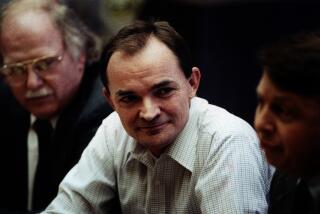Remains of pilot killed in Vietnam identified
- Share via
SAN DIEGO — The Pentagon has announced that it has identified the remains of Air Force Col. Charles J. Scharf of San Diego, whose F-4C Phantom was shot down during a bombing mission over North Vietnam in 1965.
Identification specialists have matched the DNA from a bone fragment found near the crash site with saliva from stamps on letters Scharf sent to his wife, the Pentagon said Thursday. A burial with military honors is planned for Nov. 30 at Arlington National Cemetery.
Scharf’s sister, Barbara Scharf Lowerison, 72, of Hemet, who has waged a four-decade campaign on behalf of her brother, said she does not believe the identification.
Lowerison said that the bone fragment has been in U.S. possession since 1992 and that an earlier attempt at a DNA match was a failure. She believes her brother is alive and possibly a prisoner in the former Soviet Union.
“I’ve been fighting for my brother for 41 years and I’m still fighting for him,” she said.
Lowerison voiced suspicion about the timing of the identification, which was made on the eve of President Bush’s trip to Hanoi. “It’s too much of a coincidence,” she said.
Scharf’s plane was hit by enemy fire during a mission to attack a major highway. Two other planes heard his call of “Mayday, mayday, mayday.” One plane reported seeing Scharf’s plane on fire. Another saw a parachute.
Starting with Richard Nixon, Lowerison petitioned president after president to push for an accounting of her brother. She sent each one a bracelet bearing his name. When President Clinton came to San Diego in 1993, she appealed to him to force the Vietnamese to open their files on U.S. prisoners.
When George W. Bush did not appear to be receptive to her concerns, she appealed to his father and received an encouraging letter.
She also has appealed to Russian officials, past and present, and Vietnamese officials at the United Nations. She firmly believes that her brother is visible in a propaganda film that the Vietnamese forced U.S. prisoners to participate in.
She has used the Freedom of Information Act to demand documents and has amassed 25 boxes of information.
With the rise of e-mail, Lowerison has carried on a correspondence with officials involved in identifying the remains of missing military personnel.
In an e-mail two weeks ago, Jim Canik, deputy director of the Pentagon’s DNA Registry at the Armed Forces Institute of Pathology, told Lowerison that new technology allowed the match to be made between the bone fragment and the saliva on the stamps.
In her e-mail to Canik, Lowerison noted that in 1997-98 a similar attempt to link the bone fragment and the saliva was inconclusive. Canik responded that DNA technology had advanced.
“Another important point you must realize,” Canik wrote, “is that to ensure our results, we used not only one letter, but tested multiple letters, with the testing completed by different analysts as an internal quality control measure.”
Lowerison isn’t buying. She believes that the humidity in Southeast Asia probably would have quickly dried any saliva applied to the stamps and also that stamps used by service personnel then did not require licking.
She also is suspicious of Patricia Scharf, her brother’s widow, now living in Virginia. The two have long been estranged over the issue of whether Scharf is dead or alive.
Lowerison is attempting to block the Nov. 30 burial ceremony but appears to lack official standing to do so. That does not deter her.
By contrast, Patricia Scharf, 72, who works in a jewelry store in the Pentagon, said she is “overjoyed” at the identification and the planned burial at Arlington.
Working in the Pentagon, she said, permitted her to contact key officials involved in the identification of missing personnel.
“Finally, we can bring Charles home,” she said from her home in Falls Church, Va. “He’ll have a place of honor on sacred ground with other servicemen. And now I know where I’ll be buried: right next to him.”
Scharf said she is not bothered by Lowerison’s efforts, even though she disagrees with them.
“I think she believes what she is doing is right,” she said. “And I believe what I’m doing is right.”
More to Read
Sign up for Essential California
The most important California stories and recommendations in your inbox every morning.
You may occasionally receive promotional content from the Los Angeles Times.













